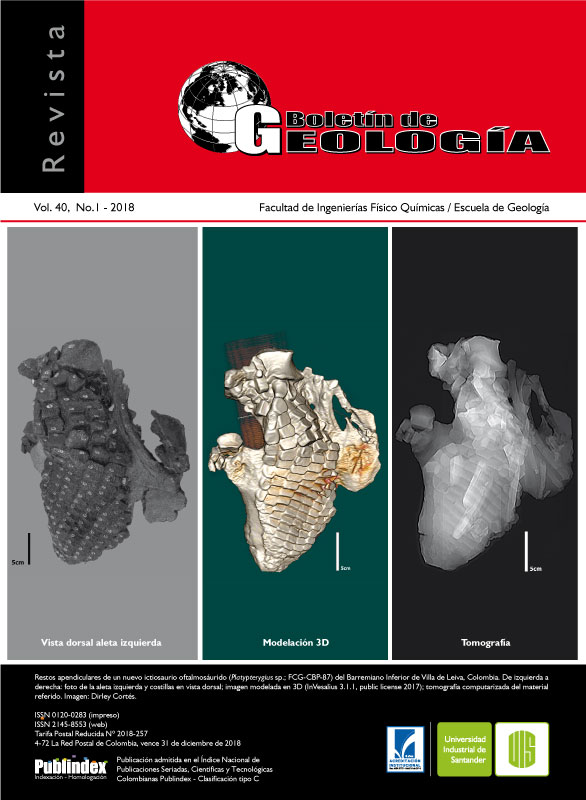Petrology of Acandí´'s Batholith and associated bodies in Unguía, Chocó, Colombia
Published 2018-02-23
Keywords
- Acandi´s Batholith,
- basalts,
- andesites,
- dacites,
- petrography
- geochemistry,
- isotopes ...More
How to Cite
Altmetrics
Abstract
The Acandi’s batholith is a large intrusive body with a wide compositional variation (Gonzalez and Londoño, 2002) dating from the Oligocene (Restrepo and Toussaint, 1976), and intruded by subvolcanic andesites and dacites bodies and basalt dikes. Due to the compositional difference of this body in the Western Cordillera, it is performed integration and interpretation of new petrographic, geochemical and isotopic data from samples collected in the northern Gulf of Urabá between the towns of Acandí and Unguía it is done in Choco department. For this area, batholith rocks are gabbros: melanocratic rocks, massive, equigranular fine to medium grained, subhedral, phaneritic texture; and the subvolcanic bodies and dikes are: leucocratic, massive and inequigranular rocks, fine to medium grained, subhedral, with sporphyritic texture and aphanitic melanocratic rocks (basalts). Detailed petrography shows that the rocks from the Batolith are constituted by plagioclase, pyroxene and amphibole, with disseminated pyrite, apatite, magnetite and ilmenite as accessory phases. The batholith rocks are holocrystalline, melanocratic, inequigranular, subhedral, from fine to granular roughly, with the presence of ophitic and subophitic textures, with reaction rings (coronas) and zoning in plagioclase. The intrusive subvolcanic rocks that crosscut the Batholith are afanitic basalts, dacites, and andesites with porphiritic textures, having plagioclase and hornblende as main minerals. They are inequigranular, very fine to coarse grained, with glomeroporphyritic texture and also vesicular and amygdular textures. Geochemical and isotopic analyses indicate that both batholiths and intrusive rocks are sub-alkaline from the calc-alkaline series of low to medium K, metaluminous with light rare earth elements enrichment in relation to the heavy rare earth elements. The geochemical and Nd and Sr isotopic data suggest that these rocks are formed in island arcs, associated with subduction zones, being later added to a continental margin.
Downloads
References
Barbarin, B. (1999). A review of the relationships between granitoid types, their origins and their geodynamic environments. Lithos, 46(3), 605-626. doi: 10.1016/S0024-4937(98)00085-1.
Batchelor, R.A., and Bowden, P. (1985). Petrogenetic interpretation of granitoid rock series using multicationic parameters. Chemical Geology, 48(1-4), 43-55. doi: 10.1016/0009-2541(85)90034-8.
Botero, G. (1975). Edades radiométricas de algunos plutones colombianos. Revista Minería, XXVII(169-179), 8336-8642.
Cossio, U. (1994). Mapa geológico y de ocurrencias minerales del departamento del Chocó, Escala 1:400.000. INGEOMINAS. Bogotá.
Cox, K.G., Beil, J.D., and Pankhurst, R.J. (1979). The interpretation of igneous rocks. London: Allen & Unwin.
DePaolo, D. (1988). Neodymium isotope geochemistry: An introduction. Berlin: Springer Verlag.
Duque-Caro, H. (1990). The Choco Block in the northwestern corner of South America: Structural, tectonostratigraphic, and paleogeographic implications. Journal of South American Earth Sciences, 3(1), 71-84. doi: 10.1016/0895-9811(90)90019-W
Gill, J.B. (1981). Orogenic Andesite sand Plate Tectonics. Berlín: Springer.
González, H., y Londoño, A.C. (2002). Catálogo de las unidades litoestratigráficas de Colombia, Batolito de Mandé, Cordillera Occidental, departamentos de Risaralda, Chocó y Antioquia. INGEOMINAS.
Harker, A. (1909). The natural history of igneous rocks. New York: Macmillan.
Hastie, A.R., Kerr, A.C., Pearce, J.A, and Mitchell, S.F. (2007). Classification of altered volcanic island Arc rocks using immobile trace elements: Development of the Th-Co discrimination diagram. Journal of Petrology, 48(12), 2341-2357. doi: 10.1093/petrology/egm062.
Hernández-Bernal, M.S., Tolson, G., y Solís-Pichardo, G. (1997). Geoquímica de elementos traza y su relación con la petrogénesis de rocas ígneas: Modelos cuantitativos de procesos magmáticos. Parte I. GEOS, 17(1), 14-22.
Irvine, T.N., and Baragar, W.R.A. (1971). A guide to chemical classification of the common volcanic rocks. Canadian Journal of Earth Sciences, 8(5), 523-548. doi: 10.1139/e71-055.
Kerr, P.F. (1959). Optical mineralogy. (3rd. ed). New York: McGraw-Hill.
Middlemost, E.A.K. (1994). Naming materials in magma/igneous rock system. Earth-Science Review, 37(3-4), 215-224. doi: 10.1016/0012-8252(94)90029-9.
Nabatian, G., Ghaderi, M., Neubauer, F., Honarmand, M., Liu, X., Dong, Y., Jiang, S.Y., von Quadt, A., and Bernroider, M. (2013). Petrogenesis of Tarom high-potassic granitoids in the Alborz–Azarbaijan belt, Iran: Geochemical, U–Pb zircon and Sr–Nd–Pb isotopic constraints. Lithos, 184-187, 324-345. doi: 10.1016/j.lithos.2013.11.002.
Pearce, J.A., Harris, N.B.W., and Tindle, A.G. (1984). Trace element discrimination diagrams for the tectonic interpretation of granitic rocks. Journal of Petrology, 25(4), 956-983. doi: 10.1093/petrology/25.4.956.
Peccerillo, A., and Taylor, S.R. (1976). Geochemistry of eocene calc-alkaline volcanic rocks from Kastamu area, Northern Turkey. Contributions to Mineralogy and Petrology, 58(1), 63-81.
Radelli, L. (1967). Geologie des Andes Colombiennes. Tesis Doctoral. Université de Grenoble. Grenoble.
Ramírez, A.O., Alminas, H., Arias, A., y Mosier, E. (1979). Estudio geoquímico en el área de Pantanos – Pegadorcito, municipios de Frontino y Dabeiba, Antioquia. Boletín Geológico, 22(2), 53-98. INGEOMINAS.
Restrepo, J.J., y Toussaint, J.F (1976). Edades radiométricas de algunas rocas de Antioquia, Colombia. Publicación Especial Geología. Universidad Nacional de Colombia.
Rodríguez, G., Sierra, M., Zapata, G., Correa, T., y Peláez, J. (2010). Geología de las planchas 58 Sapzurro (Capurganá), 68 Acandí y 79BIS Unguía (Cerro Tagarí). INGEOMINAS. Informe. Bogotá.
Shand, S, (1927). Eruptive Rocks. Nueva York: John Wiley and Sons.
Streckeisen, A. (1976). To each plutonic rock its proper name. Earth-Science Reviews 12(1), 1-33. doi: 10.1016/0012-8252(76)90052-0.
Sun, S.S., and McDonough, W.F. (1989). Chemical and isotopic systematics of oceanic basalts: implications for mantle composition and processes. In: A.D. Saunders, and M.J. Norry (Eds.), Magmatism in the ocean basins (pp. 313-345). London: Geological Society Special Publication No 42.
Villagómez, D., Spikings, R., Magna, T., Kammer, A., Winklerd, W., y Beltrán, A. (2011). Geochronology, geochemistry and tectonic evolution of the Western and Central cordilleras of Colombia. Lithos, 125(3-4), 875-896. doi: 10.1016/j.lithos.2011.05.003.
Whalen, J.B., Currie, K.L., and Chappell, B.W. (1987). A-type granites: geochemical characteristics, discrimination and petrogenesis. Contributions to Mineralogy and Petrology, 95(4), 407-419.
Winter, J.D. (2001). An introduction to igneous and metamorphic petrology. New Jersey: Prentice Hall.

